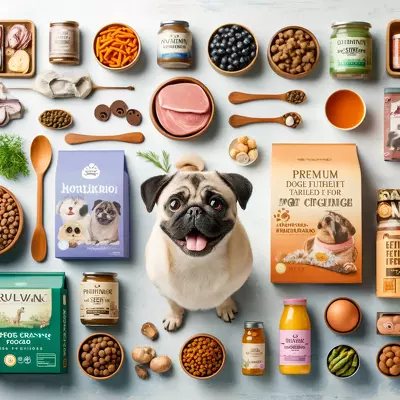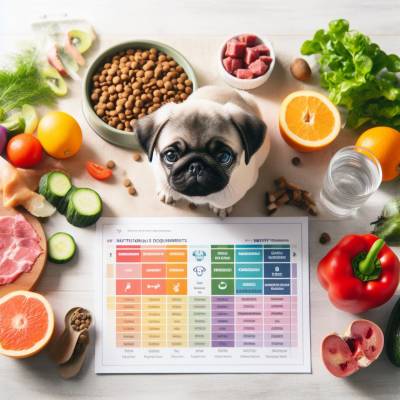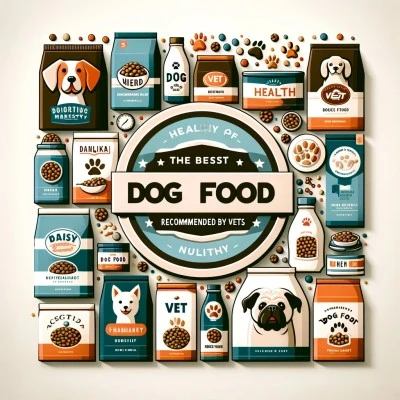Pug Palate Pleasers: Unearthing the Gold Standard in Canine Dining

Choosing the best dog food for your pug is crucial for their health and happiness. Pugs are charming, affectionate companions with unique dietary needs due to their small size and tendency towards certain health issues. Finding the right food ensures they get all the necessary nutrients to lead a lively, healthy life. This article will guide you through selecting the perfect diet for your pug, focusing on quality ingredients that cater to their specific requirements.
As an Amazon Associate, we earn a commission from qualifying purchases.
I. Introduction to Optimal Nutrition for Pugs
A. Importance of Choosing the Right Food
Selecting the appropriate diet for a pug transcends mere feeding; it’s about enriching one’s life. These small yet energetic dogs require specific nutritional components to thrive. A balanced diet supports their overall health, ensuring they live a long, vibrant life beside their owners. It’s vital to recognize that not all dog foods are created equal, especially for breeds with distinct needs like pugs.
B. Understanding Pugs’ Unique Dietary Needs
Pugs have a set of dietary requirements that set them apart from other breeds. Their compact size, energetic demeanor, and potential health challenges dictate a need for a diet that’s rich in nutrients yet moderate in calories. Proper nutrition can help manage common issues such as obesity, which pugs are prone to due to their fondness for food and relative ease of weight gain.
C. The Role of Quality Ingredients in Pug Health
The foundation of good health for any dog, especially pugs, lies in the quality of ingredients in their food. High-quality proteins, fats, and carbohydrates, alongside essential vitamins and minerals, support everything from their dense, glossy coats to their robust immune systems. Quality ingredients also contribute to the prevention of dietary sensitivities and allergies, which can be a concern for the breed.
II. Top Picks for the Best Dog Food for Pug
A. ZIWI Peak Beef Dog Food Bundle
- Key Features and Benefits
The ZIWI Peak Beef Dog Food Bundle stands out for its all-natural, high-protein, and grain-free formula. This option is crafted with air-dried beef and a selection of superfoods to deliver a nutrient-dense meal that mimics a wild diet. It’s particularly suitable for pugs, providing them with the energy they need without unnecessary fillers that can lead to weight gain. - Nutritional Profile
ZIWI’s formula is rich in protein and fats, which are essential for maintaining a pug’s muscle mass and supporting an energetic lifestyle. The limited ingredient list minimizes the risk of food sensitivities, while the inclusion of superfoods ensures a boost in antioxidants, which are crucial for long-term health.
B. Blue Buffalo Life Protection Formula
- Overview of Ingredients and Nutritional Value
Blue Buffalo’s Life Protection Formula offers a balanced diet specifically designed for puppies, including pug puppies. It combines high-quality chicken with whole grains and garden veggies, providing a well-rounded meal that supports growth and development. - Suitability for Pug Puppies
This formula addresses the needs of pug puppies through its emphasis on DHA and ARA, important fatty acids found in mother’s milk. These acids aid in cognitive development and retinal health. Its nutrient profile is tailored to help pug puppies grow up strong and healthy.
C. Taste of the Wild Sierra Mountain Grain-Free Recipe
- Composition and Health Advantages
Taste of the Wild’s Sierra Mountain recipe is a grain-free diet that features roasted lamb as its primary protein source. This choice is excellent for pugs at all life stages, offering a high protein content for muscle maintenance and overall health. The recipe is also enriched with probiotics to aid digestion and antioxidants for immune support. - How it Meets the Needs of Pugs at All Life Stages
This diet’s comprehensive nutritional approach ensures that pugs receive balanced meals throughout their lives. The absence of grain caters to those with sensitivities, and high-quality protein supports physical health from youth through adulthood.
III. Evaluating Dog Food: What to Look For
A. Assessing Protein Content and Quality
Protein is the cornerstone of a healthy diet for pugs and is necessary for muscle maintenance and energy. Owners should seek foods with high-quality animal proteins as the primary ingredient to ensure their pug is receiving the best nutrition possible.
B. Importance of Grain-Free Options
While not all pugs are sensitive to grains, a grain-free diet can benefit those who are. Grain-free formulas often substitute grains with vegetables and legumes, providing a rich source of alternative carbohydrates for energy.
C. Identifying Essential Supplements and Nutrients
Supplements like omega fatty acids, glucosamine, and chondroitin support skin, coat, and joint health, respectively. Given pugs’ susceptibility to joint issues and allergies, these additions are particularly beneficial for them.
IV. Feeding Your Pug: Practical Tips and Advice
A. Determining the Right Portion Sizes
Pugs love to eat, making it essential to monitor their portion sizes to prevent obesity. A balance between their caloric intake and activity level must be maintained for optimal health.
B. Frequency of Meals for Optimal Health
Feeding pugs two to three small meals a day can help them manage their weight and provide consistent energy levels throughout the day. This approach also aids in digestion and can prevent bloating.
C. Transitioning Foods Safely
When changing your pug’s diet, it’s important to do so gradually over several days. This method helps prevent digestive upset and allows the dog to adjust to new flavors and ingredients.
V. Common Health Concerns in Pugs and Diet’s Role
A. Obesity and Weight Management
Due to their compact size and love of food, pugs are at a high risk for obesity. A diet that is high in nutrients but low in excess calories can help manage their weight and prevent associated health problems.
B. Allergies and Sensitivities
Pugs may develop allergies or sensitivities to certain food ingredients. Identifying and choosing a diet free from common allergens can alleviate symptoms and improve quality of life.
C. Joint Health and Mobility
The breed’s structure predisposes them to joint issues. Diets enriched with joint-supporting nutrients like glucosamine and chondroitin can be beneficial in maintaining mobility and comfort.
VI. FAQs
Q: How often should I feed my pug?
A: It’s recommended that adult pugs be fed two to three small meals daily to maintain energy levels and support digestive health.
Q: Can pugs eat grain-free diets?
A: Yes, grain-free diets can be a good option for pugs, especially those with grain sensitivities or allergies.
Q: What is the best type of protein for pugs?
A: High-quality animal proteins, such as beef, chicken, or lamb, are excellent for pugs, providing them with the necessary amino acids for muscle maintenance and overall health.
Q: Are there specific supplements that should be included in a pug’s diet?
A: Pugs benefit from supplements such as omega fatty acids for skin and coat health and glucosamine and chondroitin for joint support.
Q: How can I tell if my pug is overweight?
A: A visible waistline and the ability to feel but not see their ribs are good indicators. If unsure, consult a veterinarian for a proper assessment.
Q: Is it safe to switch my pug’s food brand or type?
A: Yes, but it should be done gradually over several days to prevent digestive upset. Start by mixing a small amount of the new food with the old and gradually increase the proportion.
Q: How can diet affect a pug’s health?
A: A balanced diet supports a pug’s overall health, helping to manage weight, prevent allergies, and support joint health, contributing to a longer and healthier life.
Q: What types of dog food should I avoid feeding my pug?
A: When selecting food for your pug, it’s crucial to avoid those with high fillers like corn and soy, which offer little nutritional value and can lead to weight gain.
VII. Conclusion
A. Best Offer
Among the discussed options, the ZIWI Peak Beef Dog Food Bundle is the top recommendation. Its all-natural, high-protein, grain-free composition, enriched with superfoods, offers unmatched nutritional benefits tailored to pugs’ specific needs.
B. The Alternative
For pug owners seeking an alternative, especially for puppies, the Blue Buffalo Life Protection Formula stands out. It provides a balanced, nutrient-rich diet designed to support the growth and development of pug puppies.
VIII. Suggested Readings
Before embarking on a journey to improve your pug’s nutrition, it’s beneficial to arm yourself with knowledge. Here are a few suggested readings to get you started:
- “The Pug Handbook” by Brenda Belmonte: A comprehensive guide that includes care, health, and nutritional advice for pug owners.
- “Canine Nutrigenomics: The New Science of Feeding Your Dog for Optimum Health” by W. Jean Dodds and Diana R. Laverdure: Offers insight into how diet can influence your dog’s genetic makeup and overall health.
- “Feed Your Best Friend Better” by Rick Woodford: Provides easy recipes and feeding advice to enhance your dog’s diet and health.
Exploring these resources can provide deeper insights into how to best feed and care for your pug, ensuring they live a long, healthy, and happy life. Armed with the right knowledge and resources, you’re well on your way to providing the best possible care for your furry friend.






